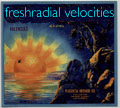
Five radial velocity datasets (published last year by Marcy et al. 2005) have just been added to the systemic console: HD 183263, HD 117207, HD 188015, HD 45350, and HD 99492. Each of these more-or-less sunlike stars is too faint to be seen with the naked eye, and each is accompanied by (at least) one detectable planet. The periods range from 17 days to several years. None of these planets were extraordinary enough to warrant much fanfare in the popular press. (Ten years ago, however, the announcement of 5 planets would have been front page news. Ahh, those were the days!)
When you use the console to obtain orbital fits to these systems, you’ll notice that several of the stars have a long-term radial velocity trend superimposed on the variations that arise from the much more readily detectable shorter-period planet. These velocity trends are likely caused by as-yet undetected massive planets lying further out in the systems, and as these stars are monitored over the long term, the orbits of these distant, frigid giants will gradually reveal themselves.
In the meantime, the residual velocity trends underscore an interesting general property of extrasolar planets. The presence of a known planet is the best indicator that a given star harbors detectable (but as-yet undetected) planetary companions. That is, if you want to find new planets, then look at stars that already have known planets. Indeed, six of the first twelve planet-bearing stars that were monitored for more than two years at Lick Observatory were subsequently been found to harbor additional bodies. This impressive planetary six-pack includes luminaries such as Upsilon Andromedae, 55 Cancri, and 47 UMa, in addition to the more pedestrian Tau Boo, HD 217107, and HD 38529. (See Fischer et al. 2001).
